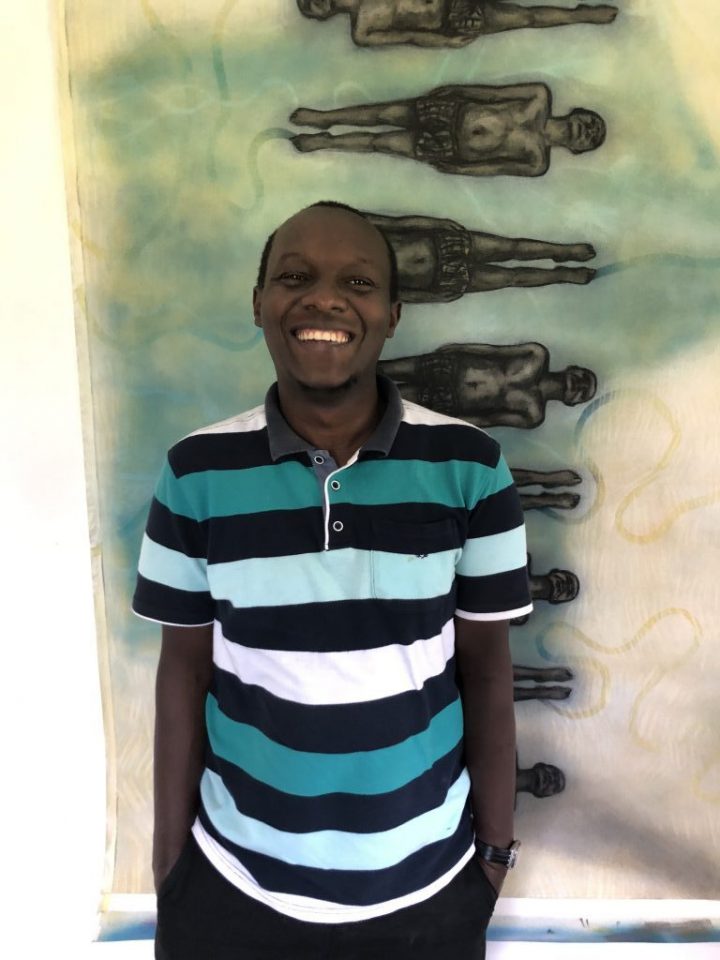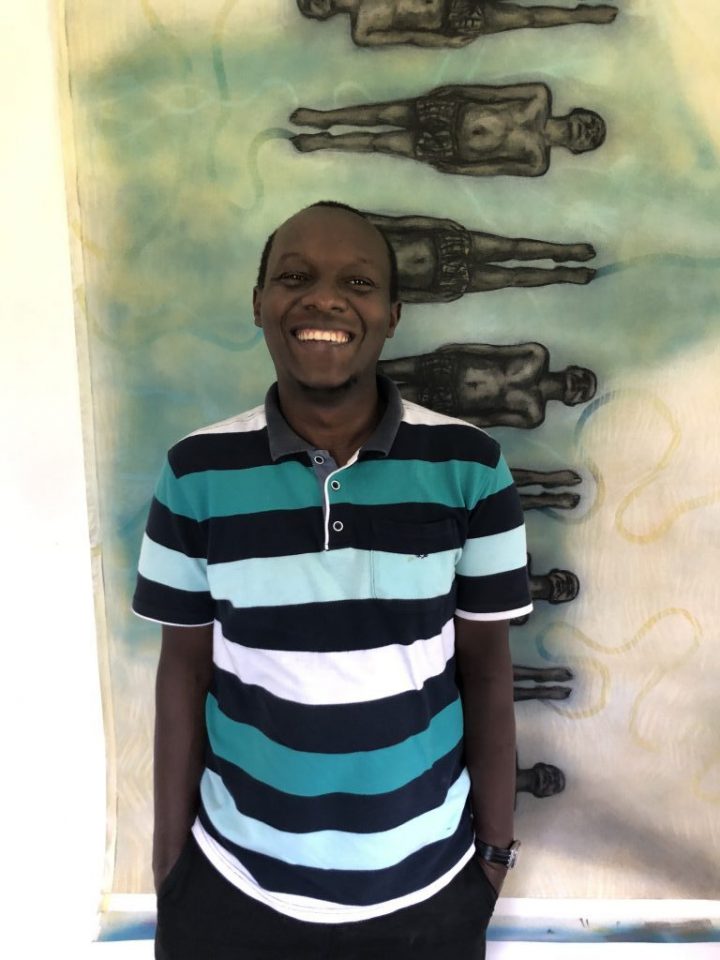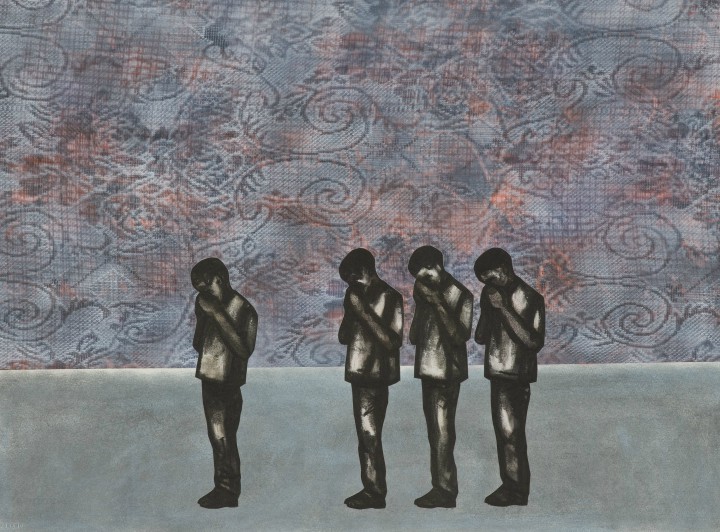INSPIRATION
Interview With Political Artist Peterson Kamwathi

Peterson Kamwathi, a leading Kenyan artist perhaps best known for his political pieces, talks to Ivy Nyayieka about his upcoming show on migration, insightful askaris and making art more democratic.

WHERE DID YOU GROW UP?
I grew up in Ngumo, Hurlingham and Uthiru. Some filters with which we perceive life have to do with the environment. Growing up in an urban housing estate contributes to my personality. I’m fascinated by structure and repetition. I decided to seriously focus on art around 2003. I dedicated myself to understanding my own work, the history of Kenya, the global space and my personal history.
WHAT DOES UNDERSTANDING YOUR ART WITHIN GLOBAL SPACES AND YOUR OWN HISTORY MEAN?
I’m fascinated by social structures exemplified by groupings and gatherings whereby the collective becomes the metaphor or identifier of a particular issue. For example, lecturers holding hands, swinging them and singing ‘solidarity forever’ is a collective act that becomes the ritual of that protest. We also just came from an election period where the queue is the perfect symbol of an electoral process.
WHAT ARE SOME OF THE HIGHLIGHTS OF YOUR EARLY CAREER?
When the crises in Darfur, East Timor and the Balkans happened, I followed everything that was being reported. I started looking at sheep as a metaphor for victims of conflict because of their meekness, especially when modern armaments are involved. Conflict has been there since time immemorial and comes in different shapes. There’s conflict that crosses borders and trickles all over to the internal spaces. What I’m doing now is looking at the spectacle of the collective as is visible in mass migration, especially towards Europe. We have people who are crossing the desert and ocean into an unknown.
HOW DO FOREIGN RESIDENCIES INFLUENCE YOUR WORK?
In as much as I think I have a sense of self, I’m not immune to all the stimuli. As much as my point of departure may be very local concerns, I’m always conscious of the fact that we are not unique. If it’s an issue of environmental change or economic disparities it resonates in Rio, Timbuktu or Kisangani. When someone screams in Kisangani, the same reverberates in Moscow. Being away might also affect my visual cues. Or it might be an awareness that there are certain solutions that have worked in other countries that may not necessarily work the same again.

WHAT ARE YOU LOOKING FORWARD TO?
I have a show coming up around migration. I am not traversing the desert or crossing the Mediterranean but that doesn’t mean that I actually cannot look at that and say that this narrative has all these deficiencies. Personally, to travel, I go and queue, get a visa, and get on a plane. The unknown on the other side is diffused because I already have faces that I am familiar with. For the project, I am looking at peoples’ hopes, strengths and aspirations. There has to be something on that other end. What is that? You are going into three geographies that are not familiar to you: you are going to a desert, you have to also try and negotiate an ocean, and then there is the Europe which you have never seen before.
TELL ME ABOUT A TIME WHERE YOUR WORK’S LOCAL AND INTERNATIONAL RELEVANCE MOST STOOD OUT TO YOU.
The position series in 2014. It was a reaction to the Westgate tragedy. I was not in Kenya as I was doing a residency up in Vermont. I remember going for breakfast in the morning when I heard these guys tell me, “Oh, sorry. Sorry about what is happening in your country.” I wasn’t sure what was going on so after breakfast, I went to watch the tragedy unfold. As the different perspectives emerged in the days that followed, I broke down the ritual of prayer as symbolised by the postures across the three principal organised religions within Kenya: Christianity, Islam and Hinduism. Then there is also the communal ritual of praying that has a collective part of it. I took about five postures within Christianity, seven for Islam and in Hinduism, I only found two. I never indicated which position belonged to which faith but the works were mixed up.
WHICH IS A MEMORABLE SHOW YOU HAVE HAD?
When I was at the GoDown, I realised that there’s a specific group of people that come to exhibitions. Then there is also an immediate community that lives or works around. We’d actually have lunch at a kiosk and the people who would come to eat there worked in the industry and had a break of about 1 ½-hours. Between eating and resting before going back for their afternoon shift,they rarely came to my studio to look at the drawings. I remember doing these wood cuts of heads, based off the community I was in then, and these two women who owned the kiosk decided to show them in their space for three days. They did it twice over two years. People noticed it within that little kiosk setting. I think we need to find ways of making art democratic.
WHAT ABOUT INTERNATIONAL FAIRS?
I did the first 1-54. It was nice to have a contemporary African theme in London. They just did the first edition in Marrakech. As much as you say the world is more connected now, nothing beats looking at artwork at a fair. You have all these different galleries from all over. Once, when I saw work by Leonard Swizzle, we had a chat with the secutity guard. He asked me “Do you know that work?” I told him that I knew of the artist. He said, “Do you know how much this piece is?” Then he gave me a figure and so I asked him, “Do you think it is worth it?” He responded, “Yeah, if I had the money, I would buy it.” He was into it, and he was ushering me into the glamour. I had a similar encounter at the Village Market in Nairobi when Manjano was happening. So I walked in and as you come up the upper level parking, you could see the works on the outside. As I was looking, the guard come and asked me what I thought of the pieces. Eventually the conversation boiled down to prices.“Wow, they are expensive,” I said. “You know, you can keep on looking at these things for a hundred years… this thing might live longer than you,” he responded, urging me to go look at the pieces inside.
Peterson Kamwathi is represented internationally by ARTLabAfrica.
TAGS
Our Top Experiences
SEEN SOMETHING YOU LIKE?
Enquire now and our team will create a custom itinerary tailored to your preferences.

CONTACT
enquiries@nomad.africa
Tel: +254 708 238 738
Purple Nomad Ltd
PO Box 69671 - 00400
Mwanzi Avenue, Nairobi, Kenya



